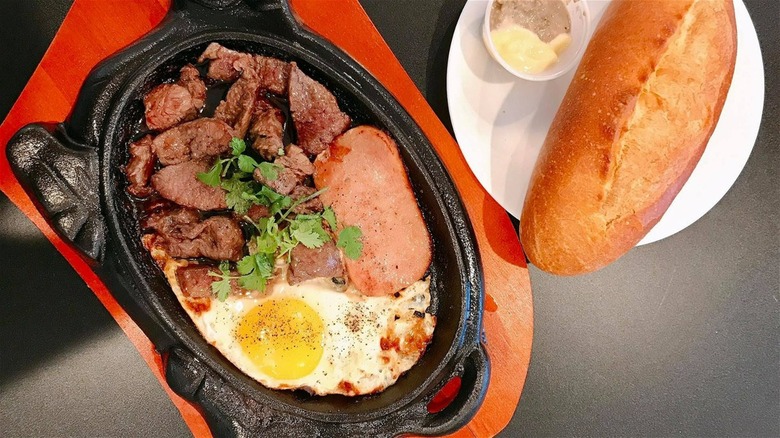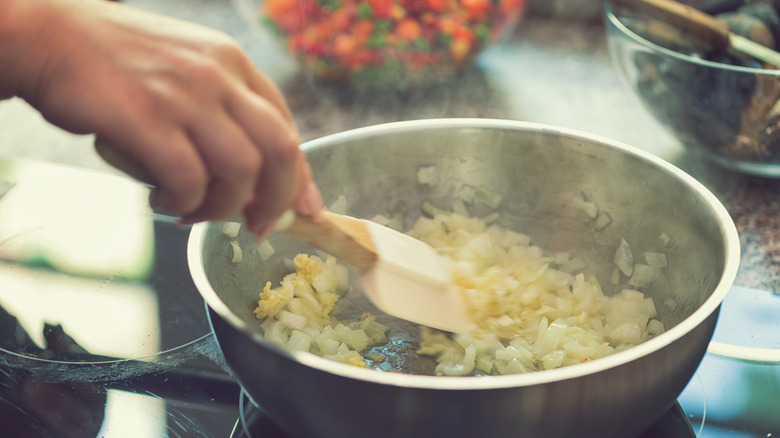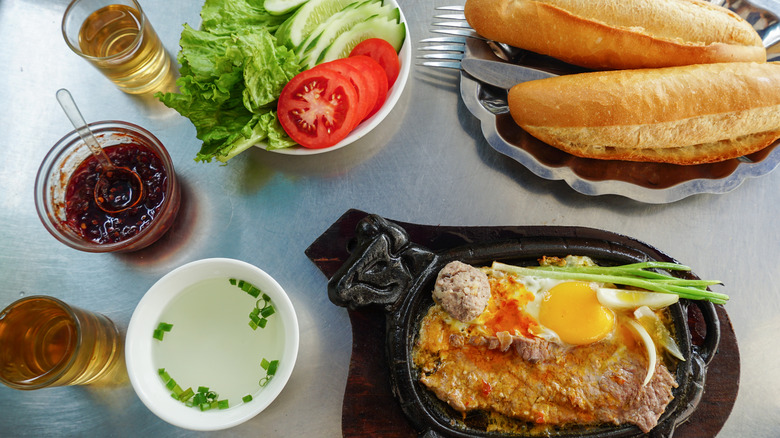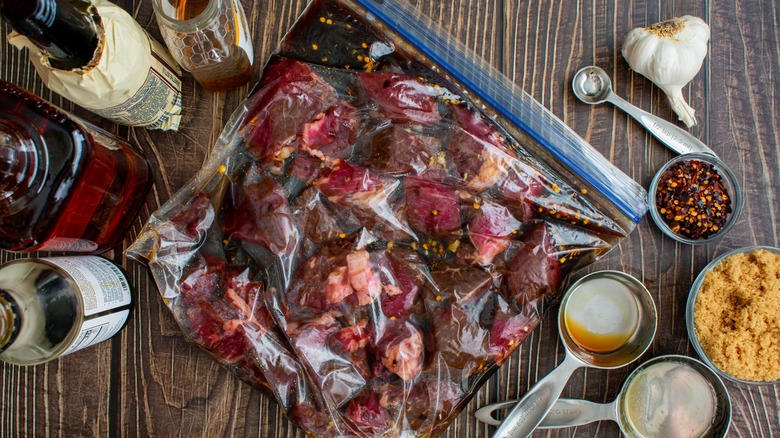Bò Né: The Vietnamese Version Of Steak And Eggs
With so many seriously delicious egg recipes that exist for breakfast and brunch, pairing them with a juicy cut of steak is all it takes to transform your morning dish into a purely hedonistic meal. It's not a combo that you'd necessarily indulge in on a regular basis, but it never fails to win over a meat lover looking to treat themselves. In Vietnam, steak and eggs is a very popular dish served on a sizzling platter and enjoyed any time of day.
Vietnamese steak and eggs, a French fusion dish known as bò né, is as tasty as it is eye-catching. The meat is marinated in rich, umami flavors before being simmered in melty butter with caramelized onions and cherry tomatoes. Eggs are usually fried sunny-side-up and garnished in green herbs, and the entire pan can be scooped up with a crusty baguette and eaten like a dip. One of the greatest strengths of bò né is its balance of multiple contrasting flavors, which makes it easy to see why it's become such a common menu staple at restaurants and street stalls throughout Vietnam.
Some ingredients traditionally featured in bò né highlight the French-Vietnamese influence the dish is famous for. And while its origins aren't specifically known, there are a few likely possibilities.
Vietnam embraced French cooking techniques during its occupation
It's no secret that France is one of the world's main food giants. Some of the most basic cooking methods that home chefs use every day are European techniques, and many dishes we've grown to love come from France. Vietnam probably took some inspiration from America's history of steak and egg breakfasts, but bò né was likely born of French influence during its colonization. After the 1880s, France occupied Vietnam, seizing its land and laborers for a span of six long decades. During that time, special ingredients and cooking methods were injected into the southeast Asian country's culinary scene. French cuisine staples like butter, pate, and the now-culturally protected baguette each became a part of a classic Vietnamese steak and eggs experience.
You can indulge in bò né in cities like Saigon, whether you're eating at a restaurant or stopping by a street food vendor. As for where you can eat it in the U.S., it's pretty easy to spot it on many Vietnamese restaurant menus, and many bò né restaurants have been popping up in bigger American cities. When you order it, you might want to prepare to duck and weave. Its name translates to "dodging beef", which refers to how one might need to steer clear of hot butter splashing off the skillet as your meal is served. Receiving this dish on a sizzling cast-iron pan is typical, and can be a satisfying sensory experience in itself.
Bò né key ingredients
The stars of Vietnamese steak and eggs are in the name. The best steak cuts for breakfast or brunch are typically tender ones like ribeye, but if you're feeling extra fancy, you could treat yourself to a juicy slab of filet mignon. The marinade has varying ingredient combinations, but it's common to find salty, umami-packed oyster, fish, or soy sauces. A few cracks of pepper is all it takes to season the steak and eggs otherwise.
Bò né is fried in butter, which caramelizes the surrounding onions and releases the aromatics of the garlic so that each element of the dish is infused with rich flavor. A dollop of pate is a must — which you can find at most grocery stores or make yourself — but it might be worth it to search for some at your local Vietnamese market if you're keen on making this dish at home. Sesame oil adds a hint of extra complexity, and brown sugar can be used to tone down the acidity of the steak's saucy marinade. Frying up a few cherry tomatoes gives the pan a pop of color, along with a bright garnish like cilantro or green onions.
Vietnamese steak and eggs is usually served with a leafy garden salad and accompanied by a French baguette. Dipping it into the bò né is one possible route, but locals will sometimes tuck the ingredients into their baguette to mimic Vietnam's hugely popular banh mi sandwich.
How to make bò né
While you don't have to marinate the steak for very long when making bò né, it can often make all the difference when it comes to amping up the flavor levels. Waiting just 15-30 minutes for sliced strips of steak to soak up the garlic and other sauces can yield deliciously savory results, but it can also be left to marinade overnight. Once that step is complete and the meat has reached room temperature to sear evenly, the other ingredients join it in the pan with heaps of butter. The eggs are added towards the last few minutes of the cooking process to achieve the perfect sunny-side-up results.
Just as a classic bahn mi is often slathered with pate, some bò né recipes will include even more ingredients from this sandwich, like picked carrots or other veggies. Squares of Vietnamese cha lua, which are lean and light pork rolls, are sometimes included in Vietnamese steak and eggs recipes to add an extra source of protein to the meal. Whichever way you slice it, bò né is certainly a drool-inducing menu option that's great for a casual brunch and doubles as a hearty comfort food to get those happy chemicals flowing.



